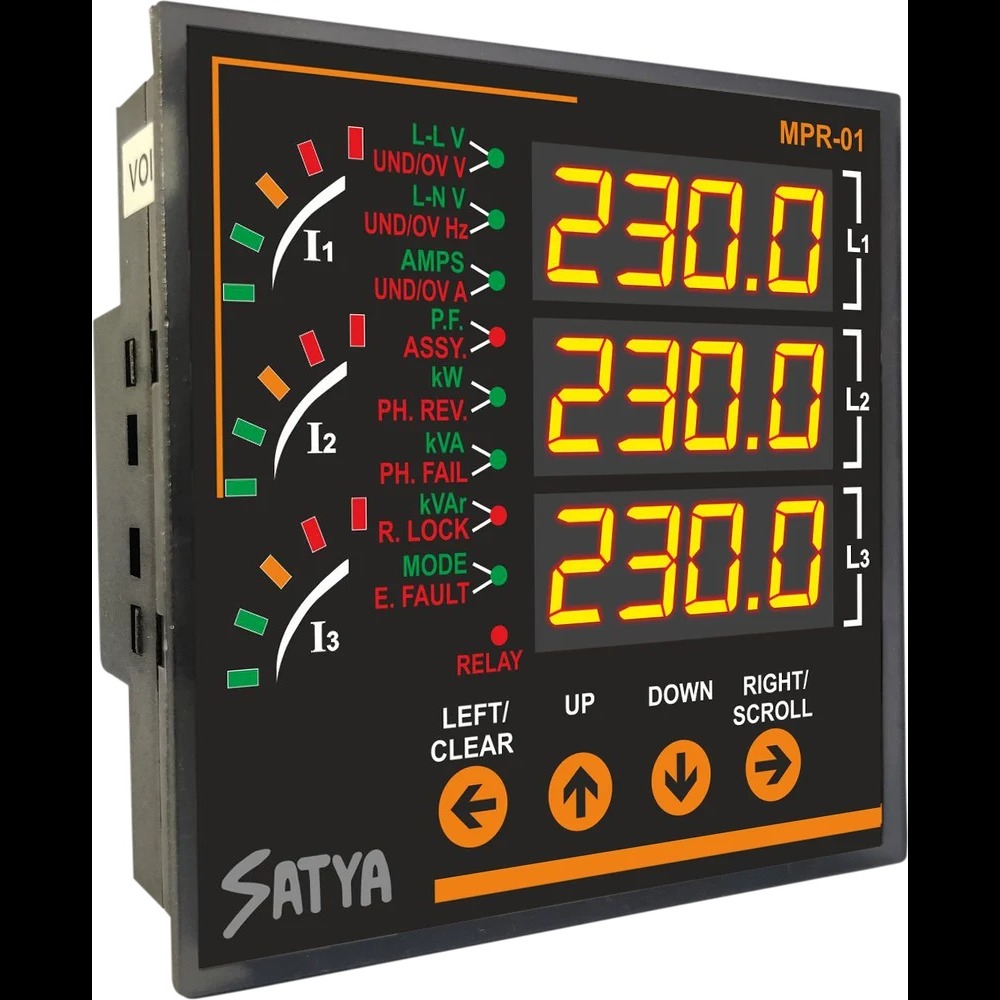An AC motor protection relay is a crucial electrical device that safeguards AC motors from damage caused by various abnormal operating conditions. These relays continuously monitor the motor's electrical parameters, such as current, voltage, and temperature. If any parameter exceeds a pre-set safe limit, the relay will trip the circuit, disconnecting the motor from the power supply to prevent failure and extend its lifespan. How an AC Motor Protection Relay Works The fundamental principle of an AC motor protection relay is to monitor the motor's operating conditions in real-time. It operates on the following principles: 1. Monitoring: The relay is connected to the motor's power supply and control circuit. It constantly monitors key electrical parameters. 2. Detection: When a fault condition, like an over current or a phase imbalance, is detected, the relay's internal mechanism is activated. 3. Action: The relay sends a signal to a contactor or circuit breaker, which then opens, interrupting the power to the motor. 4. Reset: After the fault is cleared, the relay can be reset either manually or automatically, allowing the motor to be restarted. A key consideration for motor protection is the inrush current, a temporary surge of current that occurs when a motor first starts. A motor protection relay is designed with a time delay to prevent it from tripping during this normal startup phase. The relay will only trip if the high current condition persists beyond the expected startup time. Common Types of Protection and Relays There are several types of relays, each offering specific protection. Modern relays, often microprocessor-based, can combine multiple protection functions into a single device. Common Protection Functions • Overload Protection: Protects against a prolonged over current that can cause the motor to overheat and damage its windings. This is often achieved with a thermal overload relay. • Short Circuit Protection: Protects the motor from very high currents caused by a direct short between phases or to the ground. This protection is typically handled by a circuit breaker or fuses. • Phase Failure/Loss Protection: Detects when one of the three phases in a three-phase motor's power supply is lost. The motor may continue to run on the remaining two phases, but it will draw excessive current, leading to overheating. • Phase Imbalance Protection: Monitors for unequal voltage or current among the three phases. An imbalance can cause increased motor heating and reduce its efficiency. • Under/Over Voltage Protection: Guards against power supply voltage that is too low or too high, both of which can be detrimental to the motor's performance and lifespan. • Locked Rotor Protection: Detects when the motor's rotor is stalled or 'locked, ' which causes the motor to draw a very high current, potentially leading to rapid overheating. Types of Relays • Thermal Overload Relay: This is a common and cost-effective type. It uses a bimetallic strip that bends when heated by the motor's current. If the current is too high for too long, the strip bends enough to trip a switch and shut down the motor. • Electromagnetic Relay: These relays use a coil to create a magnetic field that moves a plunger or armature. They are often used for instantaneous protection against short circuits. • Microprocessor-Based (Digital) Relay: These are highly advanced relays that use a microprocessor to monitor and analyze multiple parameters with high precision. They offer a wide range of protection functions, are highly customizable, and often include communication and diagnostic features. FEATURES:- • Single Solution to Protect your Motors from any kind of Electrical Fault • Auto / Manual Scroll Display (User selectable) • SMPS, TRANSFORMER Power Supply • Ideal for Protection of Industrial Motors • Bar Graph Indication of Load Current. • All tripping parameters fully field Programmable • User Programmable CT Ratio • TRMS Measurement • 3 Rows of 4 Digit RED Seven Segment • 3 Phase 4 wire Programmable • RS 485 Port (5KV Isolated( (Optional) • MODBUS RTU Protocol (Optional) • Two Relay Output for alarm can be provided.(optional) PARAMETERS:- • RY (Phase- Phase) Voltage • YB (Phase- Phase) Voltage • BR (Phase- Phase) Voltage • Average (Phase- Phase) Voltage • RN (Phase- Neutral) Voltage • YN (Phase- Neutral) Voltage • BN (Phase- Neutral) Voltage • Average (Phase- Neutral) Voltage • R Phase • Y Phase • B Phase • Average ALARM/TRIPS:- • Under Voltage • Over Voltage • Voltage Asymmetry/Unbalance • Phase Loss • Phase Reversal • Under Current • Over Current • Current Phase Loss • Current Imbalance • Under Frequency • Locked Rotor • Rotor Earth Fault • No Load Run/Dry Run Indication • Frequency • Run Hour • System Power Factor Kilo-wa #MPR #motorprotectionrelay #sparkelectric #protectionrelay #trending #electrical #electronics #acmotor #motorstarter
Chat with us on WhatsApp
×
This is your website preview.
Currently it only shows your basic business info. Start adding relevant business details such as description, images and products or services to gain your customers attention by using Boost 360 android app / iOS App / web portal.
https://www.sparkelectric.co.in/latest-update/ac-motor-protection-relay-mpr-dealers-supplier-in-noida-delhi-ncr/42
AC Motor Protection Relay-MPR dealers & supplier in noida & delhi/ncr...............................

2025-08-11T05:37:24
An AC motor protection relay is a crucial electrical device that safeguards AC motors from damage caused by various abnormal operating conditions. These relays continuously monitor the motor's electrical parameters, such as current, voltage, and temperature. If any parameter exceeds a pre-set safe limit, the relay will trip the circuit, disconnecting the motor from the power supply to prevent failure and extend its lifespan. How an AC Motor Protection Relay Works The fundamental principle of an AC motor protection relay is to monitor the motor's operating conditions in real-time. It operates on the following principles: 1. Monitoring: The relay is connected to the motor's power supply and control circuit. It constantly monitors key electrical parameters. 2. Detection: When a fault condition, like an over current or a phase imbalance, is detected, the relay's internal mechanism is activated. 3. Action: The relay sends a signal to a contactor or circuit breaker, which then opens, interrupting the power to the motor. 4. Reset: After the fault is cleared, the relay can be reset either manually or automatically, allowing the motor to be restarted. A key consideration for motor protection is the inrush current, a temporary surge of current that occurs when a motor first starts. A motor protection relay is designed with a time delay to prevent it from tripping during this normal startup phase. The relay will only trip if the high current condition persists beyond the expected startup time. Common Types of Protection and Relays There are several types of relays, each offering specific protection. Modern relays, often microprocessor-based, can combine multiple protection functions into a single device. Common Protection Functions • Overload Protection: Protects against a prolonged over current that can cause the motor to overheat and damage its windings. This is often achieved with a thermal overload relay. • Short Circuit Protection: Protects the motor from very high currents caused by a direct short between phases or to the ground. This protection is typically handled by a circuit breaker or fuses. • Phase Failure/Loss Protection: Detects when one of the three phases in a three-phase motor's power supply is lost. The motor may continue to run on the remaining two phases, but it will draw excessive current, leading to overheating. • Phase Imbalance Protection: Monitors for unequal voltage or current among the three phases. An imbalance can cause increased motor heating and reduce its efficiency. • Under/Over Voltage Protection: Guards against power supply voltage that is too low or too high, both of which can be detrimental to the motor's performance and lifespan. • Locked Rotor Protection: Detects when the motor's rotor is stalled or 'locked, ' which causes the motor to draw a very high current, potentially leading to rapid overheating. Types of Relays • Thermal Overload Relay: This is a common and cost-effective type. It uses a bimetallic strip that bends when heated by the motor's current. If the current is too high for too long, the strip bends enough to trip a switch and shut down the motor. • Electromagnetic Relay: These relays use a coil to create a magnetic field that moves a plunger or armature. They are often used for instantaneous protection against short circuits. • Microprocessor-Based (Digital) Relay: These are highly advanced relays that use a microprocessor to monitor and analyze multiple parameters with high precision. They offer a wide range of protection functions, are highly customizable, and often include communication and diagnostic features. FEATURES:- • Single Solution to Protect your Motors from any kind of Electrical Fault • Auto / Manual Scroll Display (User selectable) • SMPS, TRANSFORMER Power Supply • Ideal for Protection of Industrial Motors • Bar Graph Indication of Load Current. • All tripping parameters fully field Programmable • User Programmable CT Ratio • TRMS Measurement • 3 Rows of 4 Digit RED Seven Segment • 3 Phase 4 wire Programmable • RS 485 Port (5KV Isolated( (Optional) • MODBUS RTU Protocol (Optional) • Two Relay Output for alarm can be provided.(optional) PARAMETERS:- • RY (Phase- Phase) Voltage • YB (Phase- Phase) Voltage • BR (Phase- Phase) Voltage • Average (Phase- Phase) Voltage • RN (Phase- Neutral) Voltage • YN (Phase- Neutral) Voltage • BN (Phase- Neutral) Voltage • Average (Phase- Neutral) Voltage • R Phase • Y Phase • B Phase • Average ALARM/TRIPS:- • Under Voltage • Over Voltage • Voltage Asymmetry/Unbalance • Phase Loss • Phase Reversal • Under Current • Over Current • Current Phase Loss • Current Imbalance • Under Frequency • Locked Rotor • Rotor Earth Fault • No Load Run/Dry Run Indication • Frequency • Run Hour • System Power Factor Kilo-wa #MPR #motorprotectionrelay #sparkelectric #protectionrelay #trending #electrical #electronics #acmotor #motorstarter
2025-08-11T05:37:24
Keywords
- Customized motor protection relay parameters
- Digital motor protection relay features
- Locked rotor and dry run protection
- Over voltage and under voltage relay
- Short circuit protection relay for motors
- Phase failure and imbalance protection
- Industrial motor overload protection device
- Microprocessor-based motor protection relay
- AC motor protection relay supplier Delhi NCR
- AC motor protection relay dealer Noida

Submit Your Enquiry